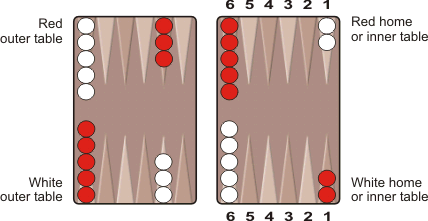|
Backgammon Variants

1970 Rules
 The standard rules of 1931 worked well and were widely adopted in North America and to a lesser extent in Europe. But as backgammon began to resurge in popularity in the late 1960s, the rules were in need of updating. The goal was to clarify some aspects of the game which were not clear in the older rules and to delete certain optional rules that were no longer used. The standard rules of 1931 worked well and were widely adopted in North America and to a lesser extent in Europe. But as backgammon began to resurge in popularity in the late 1960s, the rules were in need of updating. The goal was to clarify some aspects of the game which were not clear in the older rules and to delete certain optional rules that were no longer used.
These rules were prepared in conjunction with the International Backgammon Association and the Inter-Club League of New York. They appeared in Oswald Jacoby's and John Crawford's best-selling introduction to the game, The Backgammon Book. Prince Alexis Obolensky and Ted James published a similar set of rules around the same time.
Differences from the 1931 rules are relatively minor. A procedure is given for determining who gets which seats, checkers, and dice. The terminology is updated slightly: "throwing off" is now "bearing off." Touch rules are relaxed—you are now allowed to take back a move as long as you haven't picked up the dice. Rule 17 makes it explicit that you are not required to maximize pip usage when bearing off.
Some rules were deleted: A rethrow is no longer required if a player picks up his dice prematurely (probably a good idea). The optional scoring method of one point for each checker still on the board is no longer included.
LAWS OF BACKGAMMON
The Game
- The game is played by two persons.
- Thirty men—fifteen of one color and fifteen of another—are used, and are set up as shown below, on a standard board of four quarters or tables having six points each.

In the diagram above the players' home boards (or inner tables) are shown at the right. This means that white's home board is opposite his right hand, and black's home board opposite his left hand. In actual play it is customary to have the home boards nearer the light.
- For entering and bearing off, the points in both inner tables are considered as numbered from one to six, beginning with the point nearest the edge of the board.
- Direction of play is from adversary’s inner table to adversary’s outer table, to player’s outer table, and then to player’s inner (home) table.
- Play of the men is governed by two dice, thrown (cast) from a cup in which the dice are shaken before casting.
- (a) For the first game either player may ask to roll for choice of seats, men, or dice. Otherwise they just sit down, set the men up, and play.
(b) At the start of any later game either player may ask to mix the dice. In this case he shakes the four dice together in one cup and rolls them out. The opponent selects a die—then the roller—then the opponent—with the roller then taking the last one.
The Throws
- For the opening throw, each player throws a single die. Every tie requires another opening throw. Whoever throws the higher number wins, and for his first move plays the numbers upon both dice. After that each player in turn throws two dice.
- The dice must be shaken thoroughly, rolled together, and come to rest flat (not "cocked") upon the table at the player’s right, otherwise they must be thrown again.
- There must be a rethrow if a throw is made before an adversary’s play is completed.
- A play is deemed completed when a player moves his men and starts to pick up his dice. If he has picked them up before playing all numbers he legally can, his opponent has the right to compel him to complete or not to complete his play. A roll by the opponent is an acceptance of the play as made (see Law 19).
The Play
- The play of the men consists of:
- Moving a man (or men) the exact number of points indicated by the number on each of the two dice thrown. One man may be moved the total of the two dice thrown, or one man may be moved the number shown on one die, and an entirely different man the number shown on the other die.
- Entering a man, in the adversary’s inner table, on a point corresponding to the number on a die thrown.
- Bearing off a man in player’s inner table, when no man is left outside that table or on the bar, in accordance with Law 17.
- Doublets require four plays of the number on the dice.
- Plays must be made for both dice if possible. Either number may be played first. If either number may be played, but not both, then the higher number thrown must be played.
- No play may be made which lands, or touches down, on a point held by two or more of the adversary’s men.
- When a play lands on a point occupied by a single man (blot) of the adversary’s, such man is "hit" and must be lifted from the board by the hitter and placed on the bar in the center of the playing board, to await entry in accordance with Law 11b.
- A player having a man on the bar may not play any other man until that man has been entered.
- When in a position to bear off, you may bear off a man from a point corresponding to the number on a die thrown, or from the highest occupied point which is lower than the number indicated by a die. If a number is thrown for an unoccupied point, no man below can be borne off, using such number, while any man remains on a higher point. You are not required to bear off a man if you are able to move a man forward on the board. Law 13 applies here as in all other situations.
For example, in the diagram below you roll 6-1.

You may use the 1 to move from your six point to your five point, and then use the 6 to bear a man from the five point; thus, you don't leave a man exposed to a hit by red's men on your one point. In other words, Law 13, stating that as long as you play both numbers you may play either one first, applies in bearing off as well as at all other times.
Errors
- If an error has been made in the setup, it must be corrected if either player notices it before the second play of the game has been completed.
- If an error in play has been made, either player may require its correction before a subsequent throw. The man played in error must be correctly played; however, the player may replay his entire move.
Scoring
- A game is won by the player who first bears off all of his men.
A gammon (double game) is won if the adversary has not borne off a single man. This
doubles the count.
A backgammon (triple game) is won if the adversary has not borne off a single man and has one or more men in the winner’s inner table or upon the bar. This triples the count.
- Doubling game. The count is raised:
- Automatically: Each tie in the opening throw doubles the previous count. Automatic doubles are not played unless the players have agreed to use them and an understanding has been reached as to the method and limitation of such doubles.
- Voluntarily: Either player may offer the first optional double of the previous count. After that the right to double the previous count alternates, being always with the player who has accepted the last double.
A double or redouble may be offered only when it is the player's turn to play and before he has thrown the dice. He shall be deemed to have thrown the dice even if he rolls cocked dice.
A double may be accepted or declined. The refusal of a double terminates the game, and the player refusing loses whatever the count may amount to before the double was offered.
- Gammons double or triple the last count.
| Differences from Present-Day Rules |
- Rule 19 says that either player may require the correction of an error in play. Present-day rules are that it is solely the opponent's option whether or not to correct a play.
- Two additional rules are in widespread use today:
The Jacoby rule, which says that the winner only scores extra for a gammon or backgammon if the cube has been turned.
Beavers, which allows a player who has accepted a double to immediately redouble without giving up ownership of the cube.
|
|
References
|
![[Backgammon Galore!]](/gif/GaloreButton.gif)
 The standard rules of 1931 worked well and were widely adopted in North America and to a lesser extent in Europe. But as backgammon began to resurge in popularity in the late 1960s, the rules were in need of updating. The goal was to clarify some aspects of the game which were not clear in the older rules and to delete certain optional rules that were no longer used.
The standard rules of 1931 worked well and were widely adopted in North America and to a lesser extent in Europe. But as backgammon began to resurge in popularity in the late 1960s, the rules were in need of updating. The goal was to clarify some aspects of the game which were not clear in the older rules and to delete certain optional rules that were no longer used.
![]()


